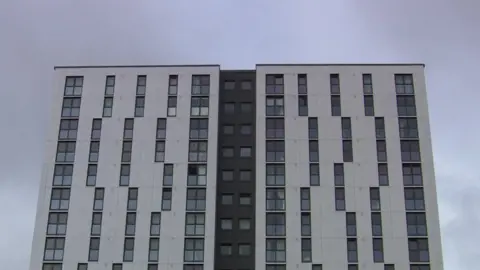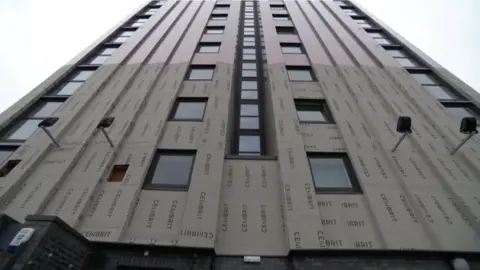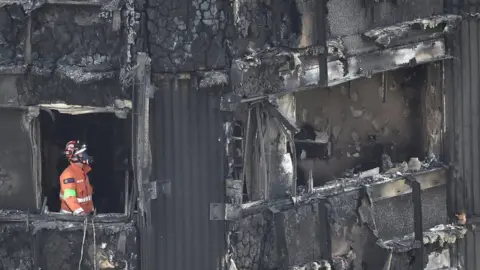Grenfell Tower fire: Soaring cost of high-rise fire safety
 BBC
BBCThe cost of fire safety measures which councils and housing associations plan to introduce to high-rise buildings after the Grenfell tragedy has now reached at least £600m, BBC research has identified.
The figure is likely to be a considerable underestimate because many public and private landlords in the UK are still calculating their budget for safety works prompted by the fire in North Kensington six months ago.
An argument is raging over who should pay for the work. The government says it will foot the bill for "essential" safety measures, but some councils and housing associations say there is confusion over who is liable.
Even before updated building regulations and fire safety rules are introduced following an official review, the cost of emergency checks, fire wardens, repairs and safety improvements is likely to be well over £1bn.
The London borough of Southwark is planning to spend £150m upgrading the safety measures in its high-rise towers. The L&Q housing association has set aside £50m for emergency safety work. Councils in Portsmouth, Leeds and Birmingham have together budgeted for £85m.
Lack of clarity
The Greater Manchester High Rise Task Force, set up after Grenfell, calculates that the cost of fire wardens and replacing dangerous cladding across the city region has already reached £100m and is still rising. Salford alone has borrowed £25m to cover such work.

But there is still confusion and frustration at what should happen to blocks fitted with cladding that failed safety checks.
Tests revealed that more than 70 blocks in Greater Manchester had unsafe cladding, but in a number of buildings, removal work has stopped because the authorities say they don't know what to put in its place.
At some towers, flammable tiles have only been partially removed, with fire wardens patrolling day and night until there is clarity on what steps to take.
Some residents say the uncertainty has left them feeling anxious and afraid.
"The more I've been thinking about it, the less sleep I've being getting," says Jon Smith, a resident in a council tower block in Salford. "I've been having broken sleep now for weeks and weeks."
The fire brigade has advised that the cladding on the bottom three floors of some towers be replaced with cement boards, but aluminium tiles that failed fire safety checks still cling to upper storeys.

"I genuinely empathise with those residents, and it must be awful to be sitting in a block with cladding that doesn't conform to building regulations," says Paul Dennett, chair of the Greater Manchester High Rise Task force and mayor of Salford.
'Industrial crisis'
"I totally appreciate the frustrations from residents and the anxieties there, but we are having a big fight with government over who is going to pay for all of this."
Mr Dennett argues that it was central government's failure to regulate the building industry that led to the Grenfell tragedy.
"This is an industrial crisis. I believe it's a failure of regulations and I believe it's a failure of government to regulate the industry, and I do genuinely believe the government should pay for this and take responsibility for it," he says.
Government ministers have said "building owners are responsible for funding measures designed to make a building safe," but that councils which have concerns about the cost of "essential fire safety measures" should contact the communities department.
With the government's Review of Building Regulations and Fire Safety not due to publish its final report until spring 2018, many housing providers across the UK are reluctant to commit to safety improvements until the post-Grenfell rules are clear.
'Absolutely lethal'
After the fire in North Kensington last June, checks in tower blocks across the UK revealed a range of safety issues that went beyond just dangerous cladding.

In Manchester, for example, the system for ensuring fire could not spread between floors in one block in Stretford was found to have been completely compromised.
"They found out that everything that I thought was possibly wrong was in fact wrong," says Phil Murphy, a former fire safety officer who lives in the Stretford tower.
"They found holes in the floors, holes in the ceiling, holes between the flats. The building was absolutely lethal."
Teams of workmen have been repairing the problems from what Phil calls "50 years of neglect". He has also started a petition for sprinklers to be fitted in every high-rise block in the country.
"If one flat had caught fire in this block, the results could have been catastrophic. It could have spread internally in a similar way to Grenfell. If they had sprinklers in the flats so that if a fire starts it suppresses it straightaway, then that would ease my concerns."
Economic impact
For decades, tower blocks in the UK relied on "passive" systems for fire safety, design features like compartmentation to stop fire spreading between flats or floors. More recently, active fire prevention systems like sprinklers have also been required, but only for certain blocks built after the regulations came in.
Many councils and housing associations say the advice they have received from fire chiefs is to retro-fit sprinklers in all their high-rise towers.
Some landlords are pushing ahead with such improvements, but others say central government must agree to pay before they commission the work.
 Reuters
Reuters"I want to fully cost this up, look at the potential economic impact here within Greater Manchester, and take that to government and ask them to pay for it," says Paul Dennett.
Dame Judith Hackitt's Review of Building Regulations and Fire Safety is expected to publish an interim report before the end of the year, but a decision on sprinklers is unlikely until the final recommendations next spring.
In the days after the Grenfell tragedy, the prime minister said she would not and could not ask people to live in unsafe homes.
Six months on and many high-rise residents are still worried that's exactly where they'll be this Christmas.
